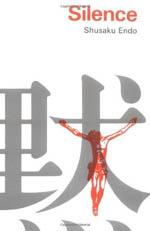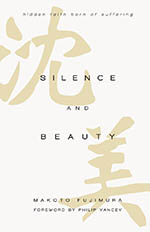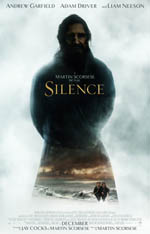Comparative Books Review and Movie Review
Silence by Shūsaku Endō. Translated by William Johnston
(New York: Taplinger Publishing Company, 1980). 192 pages. $21.01
Silence and Beauty by Makoto Fujimura
(Downers Grove, IL: InterVarsity Press, 2016). 263 pages. $26.00
Silence (2016 film). Directed by Martin Scorsese.

Longtime best-seller Silence by Japanese novelist Shūsaku Endō is a common staple of reading for university and seminary students as it powerfully describes the effort of European Christian missionaries to bring and cultivate the Gospel in 17th century Japan. Portuguese Jesuit missionaries, Fathers Rodrigues (real life Guiseppe Chiara), Santa Marta and Garrpe, embark into the unknown soil of Japan to confirm reports that their teacher/mentor, Father Ferreira, has apostatized the faith under the torturous persecution of Inoue, the dictatorial Lord of Chikugo, who followed a train of prior Japanese rulers to stamp out Christianity and force renunciation of the Christian faith under penalty of agonizing death. What follows is a harrowing detail of communities that Rodrigues and Garrpe encounter who silently live out the faith, and for many others who succumb to the persecution. They encounter a drunkard, Kichijiro, who was forced to step on the image of the Virgin Mary (the wood-cut art known as fumi-e), as a means to save his life while his own family was burned alive. Kichijiro follows Rodrigues in a roller coaster of professing faith, confessing, repenting, and renunciation. Eventually, Rodrigues meets Ferreira, who manages to convince Rodrigues to go ahead and step on the fumi-e to spare the lives of others who are being tortured, arguing that Japan is not a place where the Gospel can take root, that one must be enlightened, and that there’s no harm in Rodrigues turning away from the faith they once knew. For Ferreira, he accepted the new identity of Padre Sawano Chuan, a name given to him by Inoue. Rodrigues receives a new name, but in the closing scene, he and Kichijio silently live out their faith in exile.

Fuller Theological Seminary’s director of the Brehm Center, renowned artist Makoto Fujimura, brings a fresh perspective of East-meets-West as he explores his Japanese American heritage through the nihonga art form (use of pulverized malachite and azurite to become prismatic medium of what Fujimura calls “slow art” involving the careful layering of paints as light refracts upon the colors and paper reveal different dimensions of beauty). Fujimura sees in art and in Endō’s work the ambiguous, the hiddenness, and the beauty of Japan, whose people have had to restrain expression, such as faith, because of successive imperial conquests; and that through the use of trauma and the shock of describing trauma, shame, and guilt, Endō underscores the inner beauty that lies in the soul.
Fujimura summarized what is at stake with the fumi-e, Endō, and art: Again, this (the fact that there was surge of postwar Japanese intellectuals turning to the Catholic and Protestant faiths) proves that Japan is not a pagan culture but a Christ-hidden culture. Fumi-e hides the most precious reality of the inner journey, and often that individuality is so suppressed that it would be very difficult for Japanese to be conscious of it. Endō depicts in his writings how, on the surface, his characters hide their most glorious and hideous selves. An integrated approach to culture, what I call “culture care” (as opposed to culture wars), allows for the nurturing side of faith to develop within the soil of Japanese culture.
He then concludes:
In such an ecosystem, the gospel can come alive in ways that we have not been able to fully experience in the West, Japanese beauty is the ideal spouse to Western rationalism. (197)

What Endō did for his generation through writing, Fujimura does so for us through painting, and Scorsese dramatically puts to cinematography in a project that he devoted nearly three decades to produce. Liam Neeson (of Schindler’s List and Star Wars: Phantom Menace fame) portrayed the apostatized Father Ferreira and Andrew Garfield (of Hacksaw Ridge fame) portrayed Father Rodrigues. Scorsese shows us the human faces of agony, ambiguity, doubt, shame; we see the facial expressions, the bodily contortions, the suffering, the dramatic ironies. Neeson and Garfield put before us… us. They stand in our place as we figure out how to live out faith.
Fujimura put it so well:
. . .we may be able to gain some wisdom on how we may deal with increased enforcement of extreme ideologies that threaten to make faith a subject of fumi-e, a clear, visible line draw in the persecuted age. How do we remain faithful in a context in which dying for Christ is possible, but living for Christ is made impossible? (195, added emphasis mine)
The great value for preachers, pastors, and teachers to read, reflect upon, discuss, and pray about Endō’s, Fujimura’s and Scorsese’s work lies in the subversive beauty that lurks in the human story, which gives witness to the power of the hidden Christ who is real in our speaking and in our living… and in our silence. Selah.


